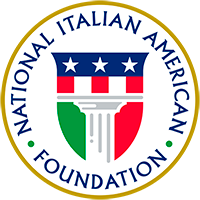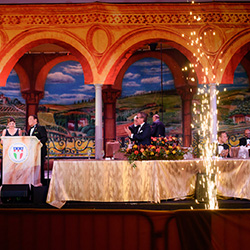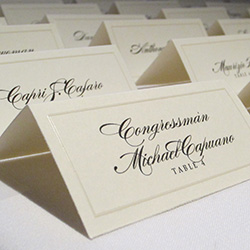
- About
-
NIAF Leadership
NIAF Board Officers
NIAF Board of Directors
NIAF Staff
Regional Leadership
- Join
- Events
- Programs
- Partnerships
- Culture
- Support
- News & Media
CLOSE- About
- Join
- Travel
- Events
- Programs
- Partnerships
- Culture
- Support
- News & Media
- Shop
- Join NIAF Today (OLD PAGE)
- Contact Us
Reflections of an American of Italian Ancestry on the Occasion of the 150th Anniversary of the Republic by NIAF President Joseph V. Del RasoFOR IMMEDIATE RELEASE
Contact: Elissa Ruffino (NIAF) 202/939-3106 or elissa@niaf.org
On the morning of March 17th, 2011, a group of patriotic Americans started their day not celebrating the feast of St. Patrick, a holiday that many say is more robustly embraced in New York than Dublin, but on the Gianicolo overlooking the Eternal City. A small delegation of the board of directors of the National Italian American Foundation” Vincent Viola, joined by his sons John and Michael, Robert Carlucci, Gabriel Battista, Arthur Furia, and myself made the pilgrimage from America to celebrate the commencement of the yearlong celebration of the birth of the Republic of Italy. We were joined by our Italian board members Paolo Catalfamo and Francesco Nicotra, who together with On. Amato Berardi arranged for a day filled with great honor and pride for our ancestral homeland.
One might ask why we were so enthusiastic to participate in this “Italian celebration.” The answer is simple — we are very proud of our Italian heritage and recognized the importance of the Italian traditions that our ancestors, the first generation of immigrants, left as their legacy to us. The day was a whirlwind of one celebratory event after another. It started with our presentation to President Napolitano of a replica of the first “Tricolore” flown in New York to the parliamentary session and culminated with Muti conducting Nabucco. As one of our delegation noted, “Wouldn’t our grandfathers be proud?” Of course!
Nostalgia is respectful of the past, but helps us shape the future. For Italian-Americans- and for all Americans — I believe there is more to the relationship between Italy and America in the 21st Century than a great affection for our ancestral homeland. It is about an alliance of two countries with common values and traditions that have shaped our philosophy on government, education, culture, and innovation. The American republic was founded on the forward-thinking philosophies of the “Age of Enlightenment,” including the writings of the Italian philosophers Beccaria, Mazzei, and Filangieri. These great thinkers helped shape the vision of our founding fathers and the birth of one of the greatest republics the world has known.
At the time of America’s birth, Italy was still divided into regional states rather than a unified national government. However, less than 100 years after our independence, Italy celebrated its own unification. One of the leaders of this movement, Garibaldi, was a respected military leader well-known in the United States (in fact, Garibaldi lived in New York for a time between his campaigns for Italian independence and unification). Abraham Lincoln consulted with him and offered him a position as a major general, and is said to have even considered appointing him to command the Union Army when the Civil War was not going well for the North. The common and shared values of the new Italian republic and the United States of the 19th Century have developed into a great and enduring friendship. The interruption of this alliance during World War II has not weakened this partnership. In fact, the alliance in the post World War II era, beginning with Italy and the United States joining as founding members of NATO and continuing to today’s shared commitment to combatting global terrorism and ensuring economic security, has thrived. No one questions Italy’s support of our strategic interests, and America’s enduring support of Italy’s security. In business and culture, too, the bonds between Italy and the United States are strong, and continue to grow.
As we look to the continuing relationship of our respective countries during this century, we must recognize our common opportunities and challenges. The creative genius of Italy in research, design and innovation is a natural marriage with the American entrepreneurial and pragmatic approach to the development and commercialization of products. America embraces Italian design and culture, and our love and respect for Italy transcends the culinary arts and couture. Collaborative research in the life sciences, automotive design and engineering, energy, and many other 21st Century initiatives will distinguish the American and Italian partnership. This partnership is critical to maintaining our collective competitive edge in the new “flat world.”
Finally, the nostalgia of the contributions of Italian immigrants in America and their immeasurable influence on our great country is absolutely compatible with the enthusiasm that today’s Americans of Italian heritage bring to their current and future role in American leadership. Their talents are shaped by ethnic heritage and values that underpin a powerful identity with their ancestral homeland. Frank Sinatra, the most famous Italian American singer of the 20th Century, recorded “The Best Is Yet to Come,” and the title of this song is a fitting description of the contemporary relationship between our great republics. Long live America and Viva Italia!
 NIAF 2023 D.C. Gala Review
NIAF 2023 D.C. Gala Review  NIAF 2023 Arizona Gala Review
NIAF 2023 Arizona Gala Review Government Affairs Events
Government Affairs Events

























